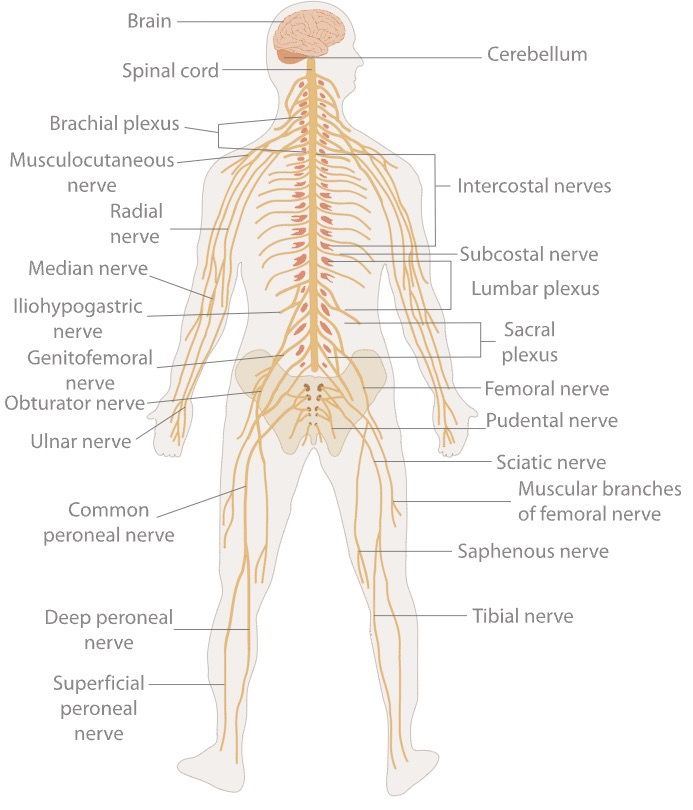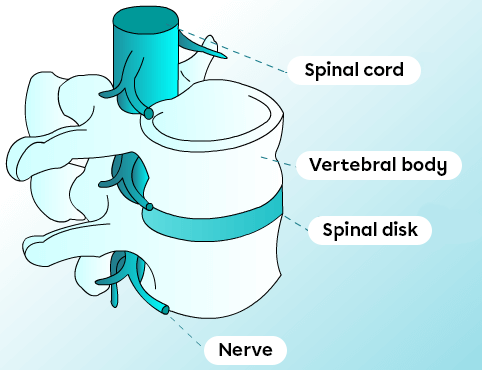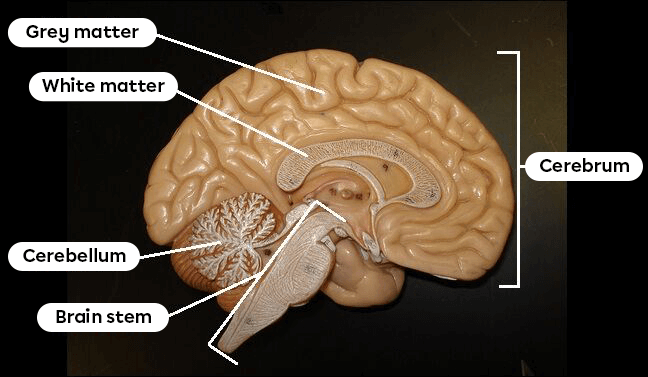The central nervous system (CNS) is the component of the nervous system that includes the encephalon and the spinal cord.
The central nervous system has two distinct components: the encephalon, which includes the brain, cerebellum and brain stem, and the spinal cord. Its role is to receive information perceived by the senses, interpret it and develop a motor response that is sent to the peripheral nervous system. This response is usually a function of the experience acquired by the individual and his nervous system. Information can be processed in different ways.

The Central Nervous System
The encephalon is the largest component of the CNS. It comprises the brain, the cerebellum and the brain stem.
The entire encephalon is protected by several layers of tissue, including the scalp, the bones of the cranium, the meninges (dura mater, arachnoid and pie mater) and the cerebrospinal fluid in which the brain is immersed. All these structures help to protect the brain, which is essential because neurons are extremely delicate cells. They need a constant environment, both in terms of oxygen concentration and glucose, in order to function properly.
The main function of the brain is to coordinate all the different systems in the body.
The brain is divided into two hemispheres: the left hemisphere and the right hemisphere. Each hemisphere is made up of grey matter, which contains the cell bodies of neurons and is responsible for processing information, and white matter, which contains mainly the axons of neurons and is responsible for transmitting information. The brain is the largest component of the encephalon, representing almost 2% of a human being's body mass.
Circumvolutions are the irregular folds in the surface of the brain and cerebellum.
The main functions of the brain are as follows.
-
It is the seat of intellectual faculties such as memory, logic and judgement.
-
It is where information from the sense organs is received, analysed and interpreted. The brain is divided into several different areas, each responsible for a particular sense.
-
It produces multiple nerve impulses, such as those that travel to the muscles to excite them and trigger motion.
Sometimes called the ‘tree of life’, the cerebellum has a bumpy appearance, rather like the brain, and is located under the brain towards the back of the skull. It is also divided into two hemispheres and is made up of white matter and grey matter.
The main function of the cerebellum is to coordinate motion and balance. The cerebellum analyses information obtained via the eyes and the balance receptors in the inner ear, as well as information relating to muscle position and the body's orientation in space. Finally, it determines several parameters of the body's movements, such as the force and speed of the motions.
The brain stem lies directly beneath the cerebrum. In fact, it is the link between the brain and the spinal cord. For an adult, it measures around 7 cm in length and varies in diameter from 1.5 cm to 2 cm.
The main function of the brain stem is to transmit information between the brain, cerebellum and spinal cord and to control the vital centres. For example, the brain stem determines breathing rate, heart frequency and blood pressure. It is also responsible for certain reflexes designed to protect the body, such as coughing, vomiting and sneezing.
The spinal cord can be compared to a long nerve cord stretching from the base of the brain stem to the lower back, at the level of the first lumbar vertebrae, which corresponds to the upper two-thirds of the spine. At the centre of the vertebrae is the vertebral canal, also known as the spinal canal, in which the spinal cord is located and protected. There are 31 pairs of spinal nerves attached to the spinal cord.

The main function of the spinal cord is to transmit impulses from the encephalon to the motor nerves and from the sensory nerves to the encephalon. As the neurons only allow impulses to pass in one direction, impulses travelling to the encephalon travel in the dorsal component of the spinal cord, while those travelling to the motor nerves travel in the front component of the spinal cord. The spinal cord also manages spinal reflexes, also known as protective reflexes.
